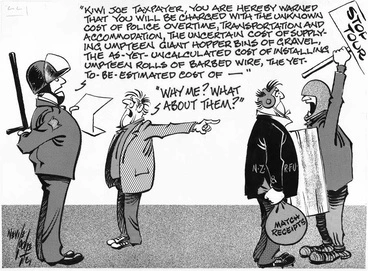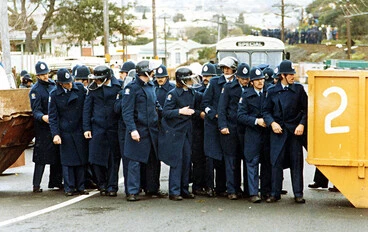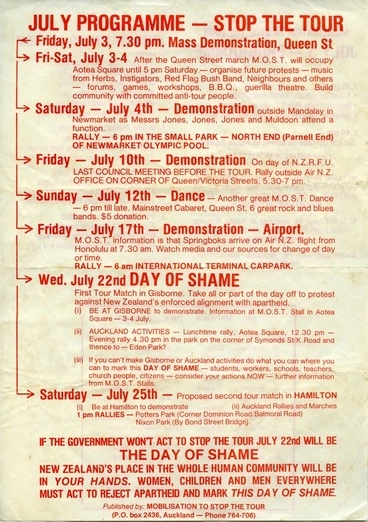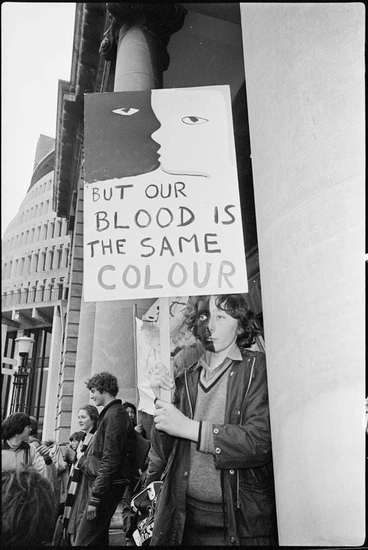The Springbok Tour
A DigitalNZ Story by Hana McIntyre
A digitalNZ story by Hana McIntyre
The springbok tour of the 1980’s was the largest civil disturbance New Zealand had seen in thirty years. The whole of New Zealand was divided over the tour, this division of the country lasted over fifty days. The Springbok tour was a real factor in the way New Zealand grew as a county. The outcomes that arose from the tour has led New Zealand to find and express our identity as people and as nation.
Maori take a stand
A group of maori protesters stand together with helmets on as police with baton smarch behind them.
Museum of New Zealand Te Papa Tongarewa
The beginning
This pamphlet was given out in the 1960's in an effort to have maori included in the tour.
Auckland War Memorial Museum Tāmaki Paenga Hira
Together as a nation
All people of NZ came together to protest the tour, despite the debate on NZ racism, people of all backgrounds joined.
Museum of New Zealand Te Papa Tongarewa
The tour was a useful tool as it helped to kick start the discussion of New Zealand's identity. For many decades New Zealand was in a limbo, we had the fundamentals of a culture events, people and objects all people could relate to. This is prominent in the source of the tour, rugby. Such a staple in ‘kiwi culture’, rugby is a thing everybody could enjoy no matter their race, age or gender. Rugby was a nationwide spot that the rest of the world knew as kiwi culture. However, this all changed when the announcement was made that the All Black would be taking am ‘all white’ team to play the springbok tour in South Africa.
Police resistance
Police and protesters in 1981
Museum of New Zealand Te Papa Tongarewa
Children joined the fight
The tour did not only see adults who fought and protested, but it also saw young children protesting with their familie.
Museum of New Zealand Te Papa Tongarewa
NZ Police 1981
Police where given 'night sticks' to keep protesters under control.
Museum of New Zealand Te Papa Tongarewa
A nation always slightly confused about where the line of culture stood between Maori natives and the pakeha. This was an event that would change the way Maori people saw themselves and their culture within New Zealand's culture. People started to stand against the tour, peaceful marches where organized, rallies with children were held. People even boycotted games in an effort to bring awareness to the fact that an ‘all white’ team was unacceptable in a country where its native people would not be included in such a prominent activity that defined the nations sporting culture.
Riot squad
The riot squad posing for a picture in 1981. They where a step up for NZ police and a shock for NZ people.
Museum of New Zealand Te Papa Tongarewa
1981
Peaceful protesters fight against the Springbok tour and for the recognition of NZ's own faults.
Museum of New Zealand Te Papa Tongarewa
Percy Bush
The uncle of the of the captain of the NZ Maori team stood with the NZ Police in napier in 1981
Alexander Turnbull Library
Maori and Pacifica people started to express their identities more, “people started to realize you can’t protest against racism 6,000 miles away when it’s right here in your country” - John Minto This quote from John Minto clearly sums up the thoughts of many people at the time. How are we as a country supposed to find a collective identity if we cannot even see the own blatant racism that happens daily in New Zealand.
The New Zealand Police force are not known to be aggressive or violent. However, the springbok tour bought out the worst in the Police of New Zealand. On the night of the 21st of July 1981 Police brought down their ‘nightsticks’ onto a crowd protester’s who refused to ‘halt’, leaving many people with injuries. This is a prominent event within the Springbok tour. However, New Zealand does not let this define our police nor do we let it impact our culture in a manner where we lost all of the good relations between police and the New Zealand public. This however did tend to complicate the traditional depictions of kiwi culture, as we now had to reinvent the culture of NZ Police.
Public opinions
The tour effected everyone, the people who had a voice in society often used it in many ways this time a comic was drawn
Manatū Taonga, the Ministry for Culture and Heritage
Police vs Civilians
The tour of 1981 hindered civilians relations with NZ Police.
Auckland War Memorial Museum Tāmaki Paenga Hira
Police force
Police men and women get ready to face another encounter with protesters.
Manatū Taonga, the Ministry for Culture and Heritage
The tour tells us many things about how kiwis expressed their identities in the past. New Zealand has never been a violent country, new Zealanders have tended to express and convey their feeling through actions and speech. This is a part of kiwi identity in itself, we don’t identify as aggressive people or a nation who is an aggressive world party. This alone reinforces the idea of traditional ‘Kiwi Culture’. We are known as a people of fierce warriors but also known as a nation of respect and understanding.
Springbok Tour protest programme
Manatū Taonga, the Ministry for Culture and Heritage
School children protesting, 1981 Springbok tour
Manatū Taonga, the Ministry for Culture and Heritage
Furthermore, this event deepened our Maori populations identity within New Zealand. The tour made many people realize how poorly our own native people has been treated within our society. This was a catalyst for the change that we see today. Over the past thirty years New Zealand’s identity has become much more inclusive of Maori and all their traditional customs. Maori have become a large part of Kiwi identity and a larger part of ‘kiwi culture’. While the tour was a confusing time for many New Zealanders its consequence of the highlighting of Maori injustice helped to confirm what we see now as ‘traditional kiwi culture’.
New Zealand has always been a proud country, we like to think that we have always had each other's backs and continue to do so even through the toughest of times. The springbok tour was a major exception to this belief. However, this tour ended up adding value and lessons to which became some of New Zealand's most important values and morals. These have now become what we call ‘Kiwi culture’.
Peaceful Protest 1981
The people of New Zealand banded together for peaceful protests against the tour in Wellington 1981
Museum of New Zealand Te Papa Tongarewa
Bibliography
References:
M. (2014, August 5). 1981 Springbok tour. Retrieved from https://nzhistory.govt.nz/culture/1981-springbok-tour
T. (2006, July 16). Springbok Tour Protests 'Good For Maori'. Retrieved from http://www.scoop.co.nz/stories/PO0607/S00145.htm
M. (2018, July 20). Police baton anti-tour protesters outside Parliament. Retrieved from https://nzhistory.govt.nz/police-baton-anti-springbok-tour-protestors-near-parliamentv
Listener, T. (2016, November 21). Inside the 1981 Springbok tour. Retrieved from https://www.noted.co.nz/archive/listener-nz-2011/inside-the-1981-springbok-tour/
Wellington City Libraries. (n.d.). Retrieved from http://www.wcl.govt.nz/heritage/tour.html
Roughan, J. (2017, August 25). NZ memories: Protests during the Springboks tour. Retrieved from https://www.nzherald.co.nz/nz/news/article.cfm?c_id=1&objectid=10830511
http://www.aucklandmuseum.com/collection/object/am_library-ephemera-11756


![[Springbok Tour - Auckland street protest] Image: [Springbok Tour - Auckland street protest]](https://thumbnailer.digitalnz.org/?resize=770x&src=https%3A%2F%2Fcollection-api.aucklandmuseum.com%2Frecords%2Fimages%2Fmedium%2F503596%2F3bc1576cf045b8332d04bd469125bbda2534badf.jpg&resize=368%253E)


